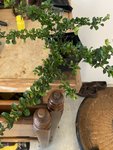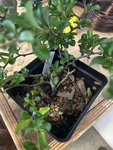b3bowen
Mame
Thanks for everyone who replied to my previous post regarding Soil attributes for chojubai. Finally got a red one, and it looks very healthy. My goal would be for it to look like this in 35 years...

my first question is, from what I read quince should be reported August/September. Average nighttime temperatures here are still around 70. And I’ve read to wait till nighttime temperatures are 65 before repotting. Clearly I am going to be very on careful untangling the roots on my new plant and I will not be cutting off any roots but should I repot now, or continue to wait until early September?
Second question, I have two stones to choose from. Which would you vote for, stone one or stone two


Clearly if the roots fit significantly better on one rock or the other I would choose the one with the best fit. However, I lean towards the first darker stone, as I think it will contrast better with the gray Roughbark over time. Even though you can’t tell in the photos, the stones are about the same size.

my first question is, from what I read quince should be reported August/September. Average nighttime temperatures here are still around 70. And I’ve read to wait till nighttime temperatures are 65 before repotting. Clearly I am going to be very on careful untangling the roots on my new plant and I will not be cutting off any roots but should I repot now, or continue to wait until early September?
Second question, I have two stones to choose from. Which would you vote for, stone one or stone two


Clearly if the roots fit significantly better on one rock or the other I would choose the one with the best fit. However, I lean towards the first darker stone, as I think it will contrast better with the gray Roughbark over time. Even though you can’t tell in the photos, the stones are about the same size.


